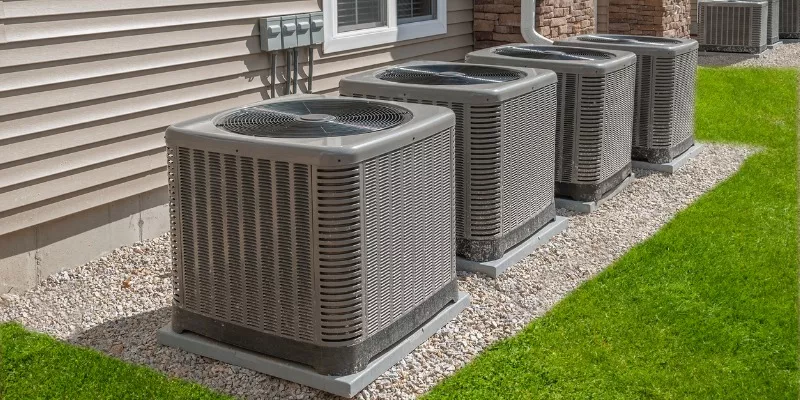
For an air conditioning unit to function properly, it requires the installation of specific components. Outdoor units have various requirements for installation, such as an AC condenser pad. Let’s take a closer look at the AC condenser pad to learn about this integral part of the system.
The AC Condenser Pad – What does it do?
ACs and heat pump outdoor units should be mounted on a solid foundation that is level. This is often called an AC condenser pad. It limits and prevents the vibrating motion of the air conditioning unit by keeping it in a stable position, allowing it to function properly with minimum malfunctions. Units that are not level will result in the outdoor fan shaft being on an incorrect angle. This will cause the fan to be more noisy than necessary and will result in premature fan failure.
Additionally, because of an AC Condenser Pad’s thick, flat surface, it elevates the air conditioning unit off the ground, providing safety from moisture and preventing insect and other pest infestation.
Types of AC Condenser Pads
There are different varieties of AC condenser pads that come in a variety of materials: concrete, plastic and concrete coated Styrofoam. The most important thing is that the pad is large enough that the unit does not significantly overhang the pad so that the weight is evenly distributed and the pad won’t shift or settle. The two most common types include:
Concrete AC Condenser Pad
Concrete Condenser Pads are built for strength. Typically, these are installed where there’s a big air conditioning system, as its strong enough to bear heavy weight. Some choose to also include patio stones beneath the air conditioner unit, but they must be installed and levelled properly.
Plastic AC Condenser Pad
These pads are typically constructed from recycled plastic or rubber. They are lighter than concrete pads, but also durable, which makes them suitable for small air conditioning units.
Whichever pad you choose will be suitable, if installed properly and level. Have questions about AC condenser pads? Find your local ClimateCare today.
Installation Guidance
When installing an AC condenser pad for your air conditioning unit or heat pump, there are many considerations, including the following:
- Pads are available in different materials, such as concrete, plastic, or a hybrid concrete-coated Styrofoam. The key aspect to consider is whether the pad is large enough to comfortably fit the unit, providing even distribution to the unit’s weight, to prevent the pad from shifting.
- To protect the life of the fan, it is imperative that the unit be level. Irregular angles can cause premature fan failure but also create additional, unnecessary noise. The unit is operating best when it runs at a smooth hum.
- Some AC condensers are installed on an outdoor wall. The unit’s size is another consideration when making a selection because it will influence which size wall brackets will be required to appropriately support your air conditioning unit.
- The outdoor unit of a heat pump must be installed at least 12″ above the anticipated snow line. This means that you must consider how high the snow can get where the unit is being located and mount it 12″ higher! The base must also allow for water to drain away when the heat pump when it defrosts in warmer weather. If the water is allowed to accumulate it will refreeze and damage the copper and aluminum coils of the heat pump. (This damage is not covered by the manufacturer’s warranty.)
For this reason, heat pumps are often mounted on wall brackets or on specifically designed heat pump stands. Care should be taken to ensure that the brackets are able to hold the weight of the unit and that the proper wall anchors are used. If a stand is used, it should be properly supported on the appropriate level pads to ensure that the unit does not shift.
How to Maintain AC Condenser Pads
- Maintaining your AC condenser pad will ensure that your air conditioning unit continues to work efficiently.
- Cut down grasses and weeds growing around the condenser pad, as they can obstruct airflow inside the air conditioning unit.
- Clean the surface by removing dirt to avoid the infestation of pests and insects. A soft brush can be used to clean the pad without using water.
- If the condenser pad is not level, add gravel and pieces of stone to maintain proper stability.
- It is crucial to monitor the outdoor air conditioning unit regularly to ensure that nothing is obstructing its function.
Contact your Local ClimateCare
These units can provide safety and security for your AC unit, elevating it off the ground to avoid infestation, inclement weather, and avoid a lot of daily wear and tear. Not only can they prolong the life of your unit, but they stabilize the unit to make sure that it performs at optimal efficiency for you.
Want to learn more about AC condenser pads and AC maintenance? Look no further! Find a local ClimateCare expert near you today.




